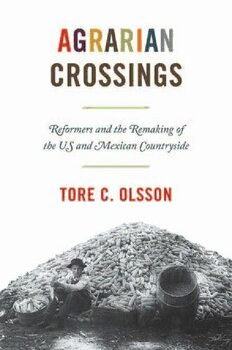
Remaking the Rural World: The American South and Mexico in the Twentieth Century PDF
Preview Remaking the Rural World: The American South and Mexico in the Twentieth Century
Agrarian Crossings America in the World Series Editors Sven Beckert and Jeremi Suri A list of titles in this series appears at the back of the book. Agrarian Crossings Reformers and the Remaking of the US and Mexican Countryside Tore C. Olsson PRINCETON UNIVERSITY PRESS PRINCETON AND OXFORD Copyright © 2017 by Princeton University Press Published by Princeton University Press, 41 William Street, Princeton, New Jersey 08540 In the United Kingdom: Princeton University Press, 6 Oxford Street, Woodstock, Oxfordshire OX20 1TR press.princeton.edu Jacket photograph courtesy of the Rockefeller Archive Center Portions of chapters 2 and 3 were previously published as Tore C. Olsson, “Sharecroppers and Campesinos: The American South, Mexico, and the Transnational Politics of Land Reform in the Radical 1930s,” Journal of Southern History 81, no. 3 (August 2015): 607– 46. All Rights Reserved Library of Congress Cataloging-in-Publication Data Names: Olsson, Tore C., author. Title: Agrarian crossings : reformers and the remaking of the US and Mexican countryside / Tore C. Olsson. Other titles: America in the world. Description: Princeton : Princeton University Press, [2017] | Series: America in the world | Includes bibliographical references and index. Identifiers: LCCN 2016047513 | ISBN 9780691165202 (hardcover : alk. paper) Subjects: LCSH: Land use, Rural—Southern States—History—20th century. | Land use, Rural—Mexico—History—20th century. | Land reform—Southern States—History—20th century. | Land reform—Mexico—History—20th century. | Agriculture and state—Southern States—History—20th century. | Agriculture and state—Mexico—History—20th century. Classification: LCC HD207 .O47 2017 | DDC 333.760975—dc23 LC record available at https://lccn.loc.gov/2016047513 British Library Cataloging- in- Publication Data is available This book has been composed in Sabon NEXT Lt Pro Printed on acid- free paper. ∞ Printed in the United States of America 1 3 5 7 9 10 8 6 4 2 To Kelli, Juniper, and my parents CONTENTS List of Illustrations ix Acknowledgments xi Introduction 1 Chapter One Parallel Agrarian Societies The US South and Mexico, 1870s– 1920s 12 Chapter Two Sharecroppers and Campesinos Mexican Revolutionary Agrarianism in the Rural New Deal 40 Chapter Three Haciendas and Plantations Finding the Agrarian New Deal in Cardenista Mexico 73 Chapter Four Rockefeller Rural Development From the US Cotton Belt to Mexico 98 Chapter Five Green Revolutions US Regionalism and the Mexican Agricultural Program 129 Chapter Six Transplanting “El Tenesí” New Deal Hydraulic Development in Postwar Mexico 159 Epilogue 191 Notes 201 Archives and Manuscript Collections Consulted 265 Index 269 ILLUSTRATIONS Figure 1.1. Emiliano Zapata, Mexican agrarian revolutionary. 22 Figure 1.2. Thomas E. Watson, agrarian populist from Georgia. 23 Figure 2.1. Frank Tannenbaum researching his dissertation in rural Mexico, 1920s. 48 Figure 2.2. Crowds welcoming Henry A. Wallace to Ciudad Victoria, Tamaulipas, November 1940. 68 Figure 2.3. Henry A. Wallace meets with farmers in Tamazunchale, San Luis Potosí, November 1940. 69 Figure 3.1. 1941 Roberto Montenegro painting of Henry A. Wallace and Centeotl, the Aztec god of maize. 84 Figure 3.2. Henry A. Wallace receiving Roberto Montenegro’s painting from the Sociedad Agronómica Mexicana, Washington, DC, October 1941. 85 Figure 3.3. Josephus Daniels and his wife, Addie, in charro costumes, Mexico City, 1937. 92 Figure 4.1. General Education Board corn demonstration in Mississippi, late 1900s or early 1910s. 107 Figure 4.2. South Carolina General Education Board corn demonstrator sits by his record- breaking harvest of 1910. 108 Figure 4.3. John A. Ferrell of the Rockefeller Foundation’s International Health Board. 114 Figure 4.4. Henry A. Wallace, Josephus Daniels, and their wives, Ilo and Addie, respectively, in Mexico City, December 1940. 121 Figure 5.1. Jalisco farmers receiving iron plows under the Plan de Movilización Agrícola, 1943. 137 Figure 5.2. Lázaro Cárdenas, Henry A. Wallace, and Marte R. Gómez touring the Rockefeller crop test plots at Chapingo, September 1946. 145 Figure 5.3. President Miguel Alemán inspecting seed to be distributed by the Comisión del Maíz, 1947. 148 Figure 6.1. Engineers Armando Bravo and José Yépez at Fort Loudoun Dam, Lenoir City, Tennessee, in August 1942. 171 Figure 6.2. President Miguel Alemán standing beside Chickamauga Dam, Chattanooga, Tennessee, May 6, 1947. 176 Figure 6.3. President Miguel Alemán with a family of former sharecroppers in Muscle Shoals, Alabama, May 6, 1947. 177 Figure 6.4. Front page of Mexico City’s Novedades, May 7, 1947. 178 Figure 6.5. Cuauhtémoc Cárdenas and Lázaro Cárdenas with Tennessee Valley Authority chair Herbert Vogel in Knoxville, Tennessee, February 3, 1959. 186 Figure 6.6. Lázaro Cárdenas crossing Fort Loudoun Dam, Lenoir City, Tennessee, February 3, 1959. 187
